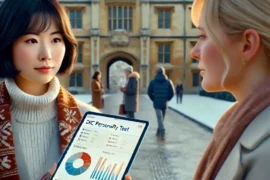Excellent work! You have a strong understanding of structured and systematic approaches.
"; } else if (scorePercentage >= 50) { resultElement.innerHTML += "Good job! There is room for improvement, so consider revisiting some concepts.
"; } else { resultElement.innerHTML += "Keep practicing! Review the feedback and explanations to enhance your understanding.
"; } resultElement.classList.remove('hidden'); } loadQuiz();Discovering Your Personality Type: A Comprehensive Guide to Understanding Yourself
Introduction
Have you ever wondered why you approach problems the way you do, or why certain social situations leave you energized while others drain you? These behaviors and preferences can be explained through personality types, which help us understand the different ways people perceive the world and interact with it. The Personality Type Test, inspired by the Myers-Briggs Type Indicator (MBTI), categorizes individuals into 16 distinct personality types based on their preferences in four key areas: Extraversion vs. Introversion, Sensing vs. Intuition, Thinking vs. Feeling, and Judging vs. Perceiving.
This article aims to deepen your understanding of these personality types by exploring each dimension, providing real-life examples, and offering insights into how you can leverage your personality traits for personal growth. By the end of this article, you’ll have a clearer picture of how your personality type influences your behavior, decisions, and relationships.
Extraversion vs. Introversion: Where Do You Find Energy?
The first dimension of personality explored in the Personality Type Test is Extraversion (E) versus Introversion (I). This dichotomy focuses on where you gain your energy—whether from the external world of people and activities or from the internal world of thoughts and reflections.
Extraversion: Thriving in Social Interactions
Extraverts are often described as outgoing and sociable. They draw energy from being around others and often feel most alive in the midst of activity. Whether it’s attending social gatherings, participating in group activities, or leading discussions, Extraverts are energized by external stimuli.
Example: Imagine you’re at a networking event. An Extravert would likely be in their element, moving from conversation to conversation with ease. They might leave the event feeling invigorated, having met new people and exchanged ideas.
Introversion: Finding Solace in Solitude
Introverts, on the other hand, recharge through solitude and quiet reflection. They often prefer deep, meaningful interactions with a few close friends rather than engaging in large social settings. Introverts may be seen as reserved, but they are often deep thinkers who value quality over quantity in their relationships.
Example: After a long day at work, an Introvert might look forward to spending time alone, reading a book, or engaging in a solitary hobby. This quiet time helps them process their day and recharge for future interactions.
Application: Understanding whether you lean more towards Extraversion or Introversion can help you manage your energy levels more effectively. For Extraverts, it’s important to schedule regular social activities that keep you motivated. For Introverts, ensuring you have enough alone time to recharge can help you maintain a healthy balance.
Sensing vs. Intuition: How Do You Gather Information?
The second dimension, Sensing (S) versus Intuition (N), relates to how you prefer to gather and interpret information. This preference affects how you see the world and the kind of information you trust.
Sensing: Focusing on the Present and Concrete Details
Sensing individuals are grounded in reality and focus on the details of the here and now. They trust information that is tangible and observable and tend to be practical and pragmatic. Sensors excel in tasks that require attention to detail and a focus on the present moment.
Example: When planning a project, a Sensing person might start by gathering all the available data and creating a step-by-step plan. They are likely to focus on what needs to be done right now, relying on facts and experience to guide their decisions.
Intuition: Looking at the Bigger Picture
Intuitive individuals, in contrast, are more interested in patterns, possibilities, and future potential. They often think about what could be rather than what is and are drawn to abstract ideas and concepts. Intuitives enjoy exploring new possibilities and are often seen as creative and innovative thinkers.
Example: The same project might be approached differently by an Intuitive person. They would likely start by brainstorming various ideas and considering how the project could evolve over time. They are less concerned with immediate details and more focused on the long-term vision.
Application: Knowing whether you prefer Sensing or Intuition can help you choose environments that align with your strengths. Sensing types might thrive in roles that require precision and a focus on practical outcomes, while Intuitive types might excel in creative or strategic roles that allow them to explore new ideas.
Thinking vs. Feeling: How Do You Make Decisions?
The third dimension, Thinking (T) versus Feeling (F), reflects how you make decisions—whether you prioritize logic and objectivity or personal values and the impact on others.
Thinking: Prioritizing Logic and Objectivity
Thinkers approach decisions with a focus on logic, fairness, and objectivity. They are often seen as analytical and detached, valuing consistency and efficiency in their decision-making processes.
Example: In a workplace conflict, a Thinker might focus on the facts of the situation and seek a solution that is logical and fair to all parties involved, even if it means making tough decisions that may not be popular.
Feeling: Emphasizing Values and Relationships
Feelers, in contrast, prioritize harmony and the emotional impact of their decisions. They are empathetic and consider how their choices will affect the people involved. Feelers strive to maintain positive relationships and often make decisions based on personal values and the desire to help others.
Example: Faced with the same workplace conflict, a Feeler might focus on the feelings of those involved, seeking a solution that preserves relationships and ensures that everyone feels heard and valued.
Application: Understanding your preference for Thinking or Feeling can help you approach decisions in a way that feels authentic to you. Thinkers may benefit from developing their empathy and considering the emotional impact of their decisions, while Feelers might work on balancing their empathy with objective analysis.
Judging vs. Perceiving: How Do You Approach Life’s Tasks?
The final dimension, Judging (J) versus Perceiving (P), reflects how you approach structure and organization in your life.
Judging: Preferring Order and Predictability
Judging individuals like to have things settled and decided. They enjoy structure, clear plans, and deadlines. Judgers often feel more comfortable when their environment is organized and predictable.
Example: A Judging person planning a vacation might create a detailed itinerary, booking flights, accommodations, and activities well in advance. They would enjoy having everything planned out, ensuring the trip runs smoothly.
Perceiving: Embracing Flexibility and Spontaneity
Perceiving individuals, however, prefer to keep their options open. They enjoy flexibility, spontaneity, and are more comfortable with ambiguity and change. Perceivers often go with the flow and adapt to new opportunities as they arise.
Example: The same vacation might be approached differently by a Perceiving person. They might prefer to leave much of the trip unplanned, deciding on activities and destinations as they go. They enjoy the freedom to explore and adapt to new experiences.
Application: Knowing whether you prefer Judging or Perceiving can help you create a lifestyle that suits you. Judgers might thrive in structured environments with clear expectations, while Perceivers might prefer dynamic settings that allow for spontaneity and exploration.
Integrating Your Personality Type
Understanding your personality type is not about limiting yourself to a specific category, but about gaining insights that help you navigate life more effectively. Each personality type has its own strengths and areas for growth, and by recognizing these, you can make more informed decisions in your personal and professional life.
Using Your Personality Type for Personal Growth
Your personality type can guide your approach to self-improvement. For example, if you’re a Judging type, you might work on becoming more flexible and open to change. If you’re a Feeling type, you might focus on developing your analytical skills to balance your empathy with logic.
Enhancing Relationships with Personality Understanding
The Personality Type Test can also improve your relationships by helping you understand and appreciate the differences in others. For instance, if you know that your partner is an Introvert, you can respect their need for downtime, even if you’re more of an Extravert. This mutual understanding can lead to stronger, more harmonious relationships.
Conclusion
The Personality Type Test is a powerful tool for self-discovery and personal development. By understanding your preferences in Extraversion vs. Introversion, Sensing vs. Intuition, Thinking vs. Feeling, and Judging vs. Perceiving, you can gain deeper insights into your behaviors, decisions, and relationships. This knowledge empowers you to make choices that align with your natural tendencies and to grow in areas that challenge you. Embrace your personality type and use it as a guide to navigate the complexities of life with greater awareness and confidence.








Comments are closed.